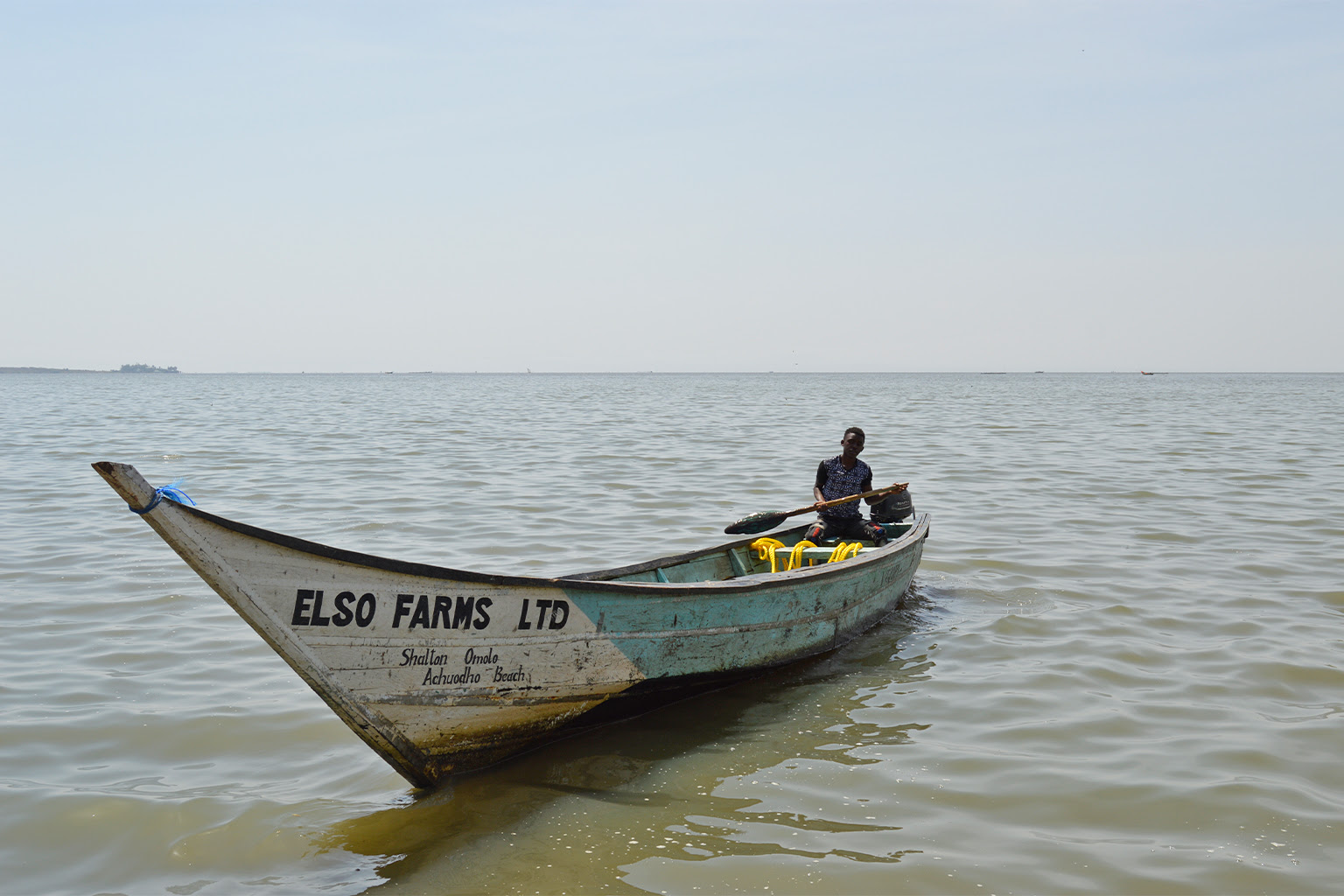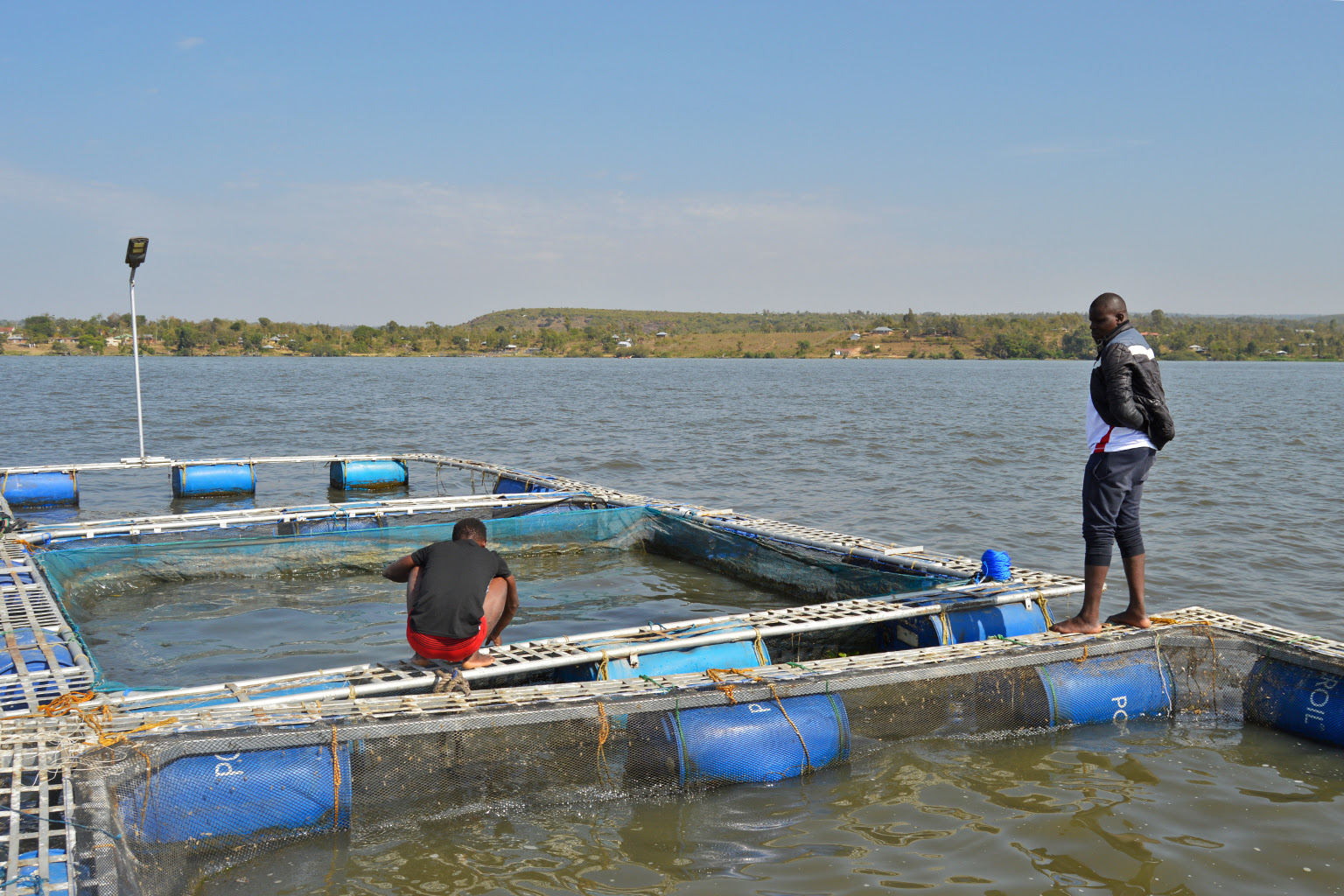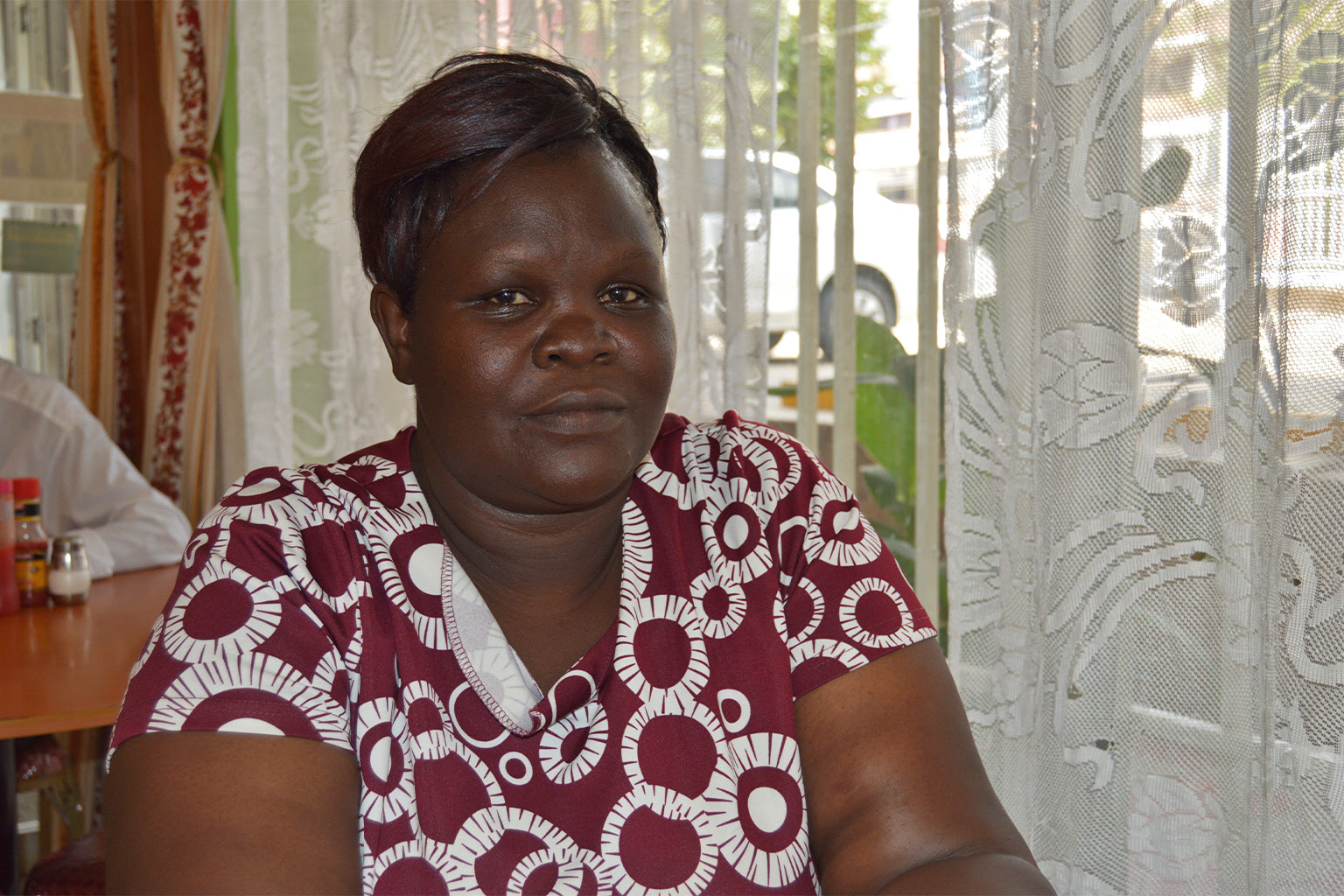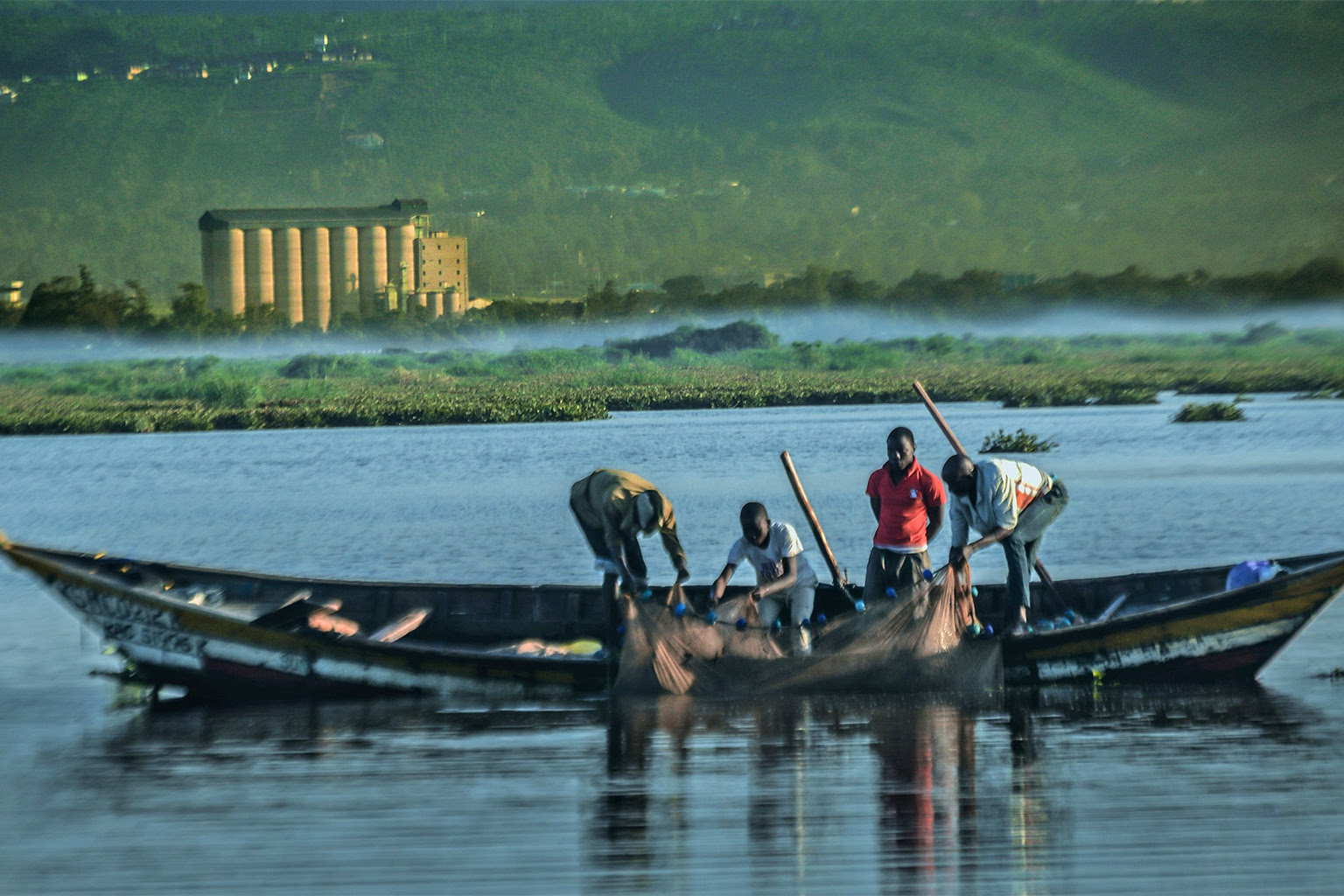- According to a Kenyan government report, fish farmers in sections of Lake Victoria lost more than 900 million Kenyan shillings ($7.2 million) in massive fish kills in November 2022.
- Scientists attribute the fish kills to reduced levels of dissolved oxygen likely due to a natural phenomenon called upwelling, which can be exacerbated by climate change and extreme weather.
- Local farmers who lost their fish, however, attribute the die-offs to pollution from Lake Victoria industries, which agencies have accused of discharging untreated effluent into the lake in recent years.
KISUMU, Kenya — It is a little past 5 p.m. at the lakeside city of Kisumu, in the western part of Kenya. An hour later, the sun sets over the sprawling Lake Victoria as far as the eye can see. Wisps of gray clouds are infused with the sun’s amber rays, which reflect off the lake in a bedazzling shimmer. The scene is captivating, but a faint stench lingers in the air. That stench, to many cage fish farmers, is a painful reminder of the extensive losses they suffered in November 2022 due to fish kills.
A report commissioned by Kenya’s State Department for Fisheries, Aquaculture and the Blue Economy estimates that cage farmers in different sections of Lake Victoria, particularly Kisumu and Homa Bay towns, lost more than 900 million shillings ($7.2 million) to fish kills in 2022. While the scientists Mongabay speaks to attribute the fish kills to a combination of natural phenomena and climate change, the fish farmers are wary of those explanations, saying the deaths could be a result of pollution.
Fish farmers in Lake Victoria mainly stock tilapia (Oreochromis niloticus), which, according to scientists, are preferred due to their fast growth, resistance to disease and ability to withstand low dissolved oxygen levels. Tilapia and Nile perch (Lates niloticus) are the two most abundant fish species in the lake, and tilapia is more profitable in the local market.
Two of the fish farms, Kentila Farms and Lake Aqua Limited, suffered the greatest losses: 200.4 million shillings ($1.6 million) and 138 million shillings ($1.1 million), respectively, according to the government report. Although the fish kills happened in November, the memories of the losses are still fresh in people’s minds months later.
At Ogal Beach, the section of the lake where farmers were worst hit, there is a flurry of activity as fishers return from early morning fishing expeditions. They are gradually easing back into their routines. It is not until you engage the fishers that you begin to understand the hurt some of them bear beneath the apparent normalcy.
“I do not want to talk to the media anymore. … Nothing comes out of it! It is like opening an old wound that I would rather forget,” says Jacob Okomo, a fish farmer at Ogal Beach who deals in tilapia. It is unclear how much loss he suffered, since he does not talk about what happened.
 Shalton Omolo’s assistant rowing Omolo’s boat. Most fish farmers in Kisumu use similar boats. Image by Calvin Rock Odhiambo for Mongabay.
Shalton Omolo’s assistant rowing Omolo’s boat. Most fish farmers in Kisumu use similar boats. Image by Calvin Rock Odhiambo for Mongabay.
Low levels of dissolved oxygen can kill fish
Many of the fish farmers lost their fish to massive die-offs usually attributed to reduced levels of dissolved oxygen (DO) in water — a phenomenon that commonly results in what is referred to as fish kills.
According to a review article published in the journal Fisheries Management and Ecology, Lake Victoria fish kills in recent years have been attributed to reduced dissolved oxygen content in the water. The article, which references incidents in 2016 at two other beaches on the lake — Anyanga and Nyenye-Got — notes a number of reasons for reduction in oxygen levels, including poor water circulation in the cages due to algae and feed residues as well as possible upwelling around the cages.
“Upwelling [occurs] when the water at the bottom [of the lake] rises, and the water at the bottom of the lake or sea is usually low in oxygen,” says Chrispine Nyamweya, a researcher at the Kenya Marine and Fisheries Research Institute (KMFRI). Nyamweya, who specializes in limnology (the study of inland aquatic ecosystems), explains that processes like decomposition, which uses oxygen, cause deficiency in the bottom column of water, which rises to the top during upwelling.
“When there is wind action or changes in water temperature, which changes the densities, water from the bottom rises up to the surface in the process … killing fish because of suffocation,” Nyamweya says. “Upwelling occurs at predictable times of the year but sometimes because of climate change and extreme weather conditions, these events happen at places and times we don’t expect.”
 A fisher repairs his fishing net at Achodho Beach in Kisumu County. Image by Calvin Rock Odhiambo for Mongabay.About half a kilometer across from Ogal Beach is Achuodho Beach. Shalton Omolo, a cage farmer who deals in tilapia, says he lost more than 4 million shillings ($32,000) to fish kills in November. He started ELSO farms in 2019; using proceeds from aquaculture, he invested in beekeeping and goat rearing, selling honey and goat meat to boost his income. Unlike Okomo, he is willing to talk about his experience of discovering dead fish in their cages. He speaks with passion, recalling the Friday it happened.
A fisher repairs his fishing net at Achodho Beach in Kisumu County. Image by Calvin Rock Odhiambo for Mongabay.About half a kilometer across from Ogal Beach is Achuodho Beach. Shalton Omolo, a cage farmer who deals in tilapia, says he lost more than 4 million shillings ($32,000) to fish kills in November. He started ELSO farms in 2019; using proceeds from aquaculture, he invested in beekeeping and goat rearing, selling honey and goat meat to boost his income. Unlike Okomo, he is willing to talk about his experience of discovering dead fish in their cages. He speaks with passion, recalling the Friday it happened.
“We woke up very early, prepared to harvest because we had a lot of orders and clients were waiting for us in town and some were waiting for us at the beach,” Omolo says. “When we were about to arrive at the farm [fish cages] we were met by some funny smell, but we assumed everything was OK.”
Upon arrival, Omolo says, he and his assistants found thousands of fish floating in the water inside the cages. He was forced to call his customers, mostly hoteliers, informing them of what had happened. He had no option but to refund the money some of them had already paid.
“At first I thought it was foul play; I thought it was a human act because I had advertised and people [customers] were really waiting on their orders. I thought somebody might have poisoned the fish,” Omolo says. “I mostly deal with hotels and Fridays are good days because we are heading to the weekend so sales are really good and hotels want their fish supplied as early as possible — latest 7 a.m.”
Omolo says he later found out that other fish farmers in other areas of the lake had also been affected. He then realized the fish could have died from natural causes, although he remains skeptical.
 Shalton Omolo steering his boat offshore. Image by Calvin Rock Odhiambo for Mongabay.Things have not been easy for Omolo, who has two school-going children and siblings who depend on him. Even though he is slowly getting back on his feet, he says he is still burdened by the uncertainty of what the future holds.
Shalton Omolo steering his boat offshore. Image by Calvin Rock Odhiambo for Mongabay.Things have not been easy for Omolo, who has two school-going children and siblings who depend on him. Even though he is slowly getting back on his feet, he says he is still burdened by the uncertainty of what the future holds.
“By the time I lost my fish, all the fish were ready for harvest and I had 80,000 pieces of fish [individual fish]. The total stock was amounting to 3 million shillings ($23,000); when the government did their calculation it was amounting to 4.6 million (just over $35,000) because of other factors left out during my calculation,” he says.
The cost of constructing a cage of 6-by-6-by-4 meters (20-by-20-by-13 feet) is about 400,000 shillings ($3,000), Omolo says, without factoring in the cost of fish fingerlings, which cost 4 shillings ($0.03) each. He also fed the fish twice daily at a cost of 100,000 ($800) shillings per cage, until the fish were ready for market. At the time he lost the fish, he had 12 cages.
Ironically, aquaculture was introduced to Lake Victoria as a lucrative alternative to fish hunting while also solving the problem of dwindling fish volumes in the lake. However, with the losses farmers incurred, many are wondering whether it is worth the investment.
A report published in the International Journal of Fisheries and Aquatic Studies, which focuses on fish kills in Lake Naivasha in February 2010, notes that suffocation as a result of oxygen depletion is “often” the cause of fish kills. Further, the report highlights “natural causes” such as “climatic conditions that can lead to deoxygenation of the water, diseases, stress, toxic algae, thermal shock and salinity shock among other factors.”
 Omolo’s assistant and Omolo inspecting the fish nets. Image by Calvin Rock Odhiambo for Mongabay.Omolo, however, suspects there could be more to the fish kills than just “natural cause,” which, he says with skepticism, the scientists from KMFRI refer to as “an act of God.”
Omolo’s assistant and Omolo inspecting the fish nets. Image by Calvin Rock Odhiambo for Mongabay.Omolo, however, suspects there could be more to the fish kills than just “natural cause,” which, he says with skepticism, the scientists from KMFRI refer to as “an act of God.”
“Everybody knows what happened. Things like ‘natural phenomena,’ things like ‘upwelling,’ people are just trying to hang onto them — those are jargons to me but we know very well what really affected the lake and what is killing the fish,” Omolo says. “What is happening is: We are losing our fish due to the pollution in the lake.”
He points a finger at companies around the Lake Victoria Basin accused of discharging effluents into the lake. His sentiments are echoed by Okomo and Michael Nyaguti, an environmentalist based in Kisumu, both of whom blame the die-offs on pollution. According to them, a discoloration on some sections of the lake is clear evidence of pollution. Nyaguti describes the color as that of “strong [black] tea.”
In 2020, Chris Kiptoo, who was then principal secretary of environment and forestry, singled out institutions and industries complicit in polluting Lake Victoria to Kenya’s environment watchdog, the National Environment Management Authority (NEMA), saying that 102 companies from 14 counties were responsible. In March 2022, NEMA said it would shut down 13 facilities for discharging untreated effluent into the water. As of publication, NEMA has not responded to Mongabay’s request for comment and an update on the situation.
Nevertheless, Susan Adhiambo, the Kisumu County director of fisheries, is quick to dispute the allegations that the November fish kills were caused by extensive pollution.
“If it was pollution, it would have happened in the whole lake. … These deaths were sporadic at specific points, and there is no evidence that there is pollution taking place at those points. So I cannot clearly say it was pollution without sound evidence to prove [it].”
 Susan Adhiambo, the Kisumu County director of fisheries. Image by Calvin Rock Odhiambo for Mongabay.
Susan Adhiambo, the Kisumu County director of fisheries. Image by Calvin Rock Odhiambo for Mongabay. Fishermen gathering their catch early in the morning on Lake Victoria. An industrial unit at the lake’s banks can be seen in the background. Image by Franklin Amulyoto via Wikimedia Commons (CC BY-SA 4.0).She backs upwelling as the cause of the fish kills as indicated by researchers and scientists from the government. “[Upwelling] can be predictable, but with climate change, there are so many changes … even temperature patterns are changing, so it is becoming unpredictable,” Adhiambo says.
Fishermen gathering their catch early in the morning on Lake Victoria. An industrial unit at the lake’s banks can be seen in the background. Image by Franklin Amulyoto via Wikimedia Commons (CC BY-SA 4.0).She backs upwelling as the cause of the fish kills as indicated by researchers and scientists from the government. “[Upwelling] can be predictable, but with climate change, there are so many changes … even temperature patterns are changing, so it is becoming unpredictable,” Adhiambo says.
She adds that not all regions of the lake are suitable for cage farming, and that overcrowding the lake with fish cages may contribute to pollution.
Like Adhiambo, Nyamweya says the fish cages were most likely set up in areas unsuitable for fish farming, and that could have been the greatest contributor to the fish kills. He says that while pollution may also cause reduced levels of oxygen in the lake, it is unlikely that it was the cause of the November 2022 fish kills as many more fish farms across the lake would have been affected.
“I can say for certain that these fish kills were as a result of overcrowding and being set up in unsuitable areas.”
Despite Nyamweya and Adhiambo’s stand, Nyaguti, who is the founder of Magnam Environmental Network, a pro-conservation community-based organization, says pollution is largely to blame.
 Shalton shares a light moment with Michael Nyaguti. Nyaguti runs a pro-conservation CBO called Magnum Environment Network. Image by Calvin Rock Odhiambo for Mongabay.“[T]hey were saying it is because of climate change issues and therefore they could not control it,” Nyaguti says, “but we still call for more research because much as we have water hyacinth rotting … we are aware that a lot of pollutants are still entering into the lake.”
Shalton shares a light moment with Michael Nyaguti. Nyaguti runs a pro-conservation CBO called Magnum Environment Network. Image by Calvin Rock Odhiambo for Mongabay.“[T]hey were saying it is because of climate change issues and therefore they could not control it,” Nyaguti says, “but we still call for more research because much as we have water hyacinth rotting … we are aware that a lot of pollutants are still entering into the lake.”
At the moment, scientists can only present the most likely causes of the fish kills. It could have been a combination of many things, including drought, which, according to the report in the International Journal of Fisheries and Aquatic Studies, also causes fish kills.
Nonetheless, fish farmers like Omolo and Okomo have suffered massive losses. Their hope is that the Kisumu county government, together with the national government, will implement the recommendations proposed by a task force investigating the fish kills — particularly, offering financial and psychosocial support to the affected farmers. Yet, more importantly, they say, scientists should conduct more research and come up with ways to prevent fish kills in the future — for this remains their greatest fear.

 Fashion7 years ago
Fashion7 years ago

 Shalton Omolo’s assistant rowing Omolo’s boat. Most fish farmers in Kisumu use similar boats. Image by Calvin Rock Odhiambo for Mongabay.
Shalton Omolo’s assistant rowing Omolo’s boat. Most fish farmers in Kisumu use similar boats. Image by Calvin Rock Odhiambo for Mongabay. A fisher repairs his fishing net at Achodho Beach in Kisumu County. Image by Calvin Rock Odhiambo for Mongabay.About half a kilometer across from Ogal Beach is Achuodho Beach. Shalton Omolo, a cage farmer who deals in tilapia, says he lost more than 4 million shillings ($32,000) to fish kills in November. He started ELSO farms in 2019; using proceeds from aquaculture, he invested in beekeeping and goat rearing, selling honey and goat meat to boost his income. Unlike Okomo, he is willing to talk about his experience of discovering dead fish in their cages. He speaks with passion, recalling the Friday it happened.
A fisher repairs his fishing net at Achodho Beach in Kisumu County. Image by Calvin Rock Odhiambo for Mongabay.About half a kilometer across from Ogal Beach is Achuodho Beach. Shalton Omolo, a cage farmer who deals in tilapia, says he lost more than 4 million shillings ($32,000) to fish kills in November. He started ELSO farms in 2019; using proceeds from aquaculture, he invested in beekeeping and goat rearing, selling honey and goat meat to boost his income. Unlike Okomo, he is willing to talk about his experience of discovering dead fish in their cages. He speaks with passion, recalling the Friday it happened. Shalton Omolo steering his boat offshore. Image by Calvin Rock Odhiambo for Mongabay.Things have not been easy for Omolo, who has two school-going children and siblings who depend on him. Even though he is slowly getting back on his feet, he says he is still burdened by the uncertainty of what the future holds.
Shalton Omolo steering his boat offshore. Image by Calvin Rock Odhiambo for Mongabay.Things have not been easy for Omolo, who has two school-going children and siblings who depend on him. Even though he is slowly getting back on his feet, he says he is still burdened by the uncertainty of what the future holds. Omolo’s assistant and Omolo inspecting the fish nets. Image by Calvin Rock Odhiambo for Mongabay.Omolo, however, suspects there could be more to the fish kills than just “natural cause,” which, he says with skepticism, the scientists from KMFRI refer to as “an act of God.”
Omolo’s assistant and Omolo inspecting the fish nets. Image by Calvin Rock Odhiambo for Mongabay.Omolo, however, suspects there could be more to the fish kills than just “natural cause,” which, he says with skepticism, the scientists from KMFRI refer to as “an act of God.” Susan Adhiambo, the Kisumu County director of fisheries. Image by Calvin Rock Odhiambo for Mongabay.
Susan Adhiambo, the Kisumu County director of fisheries. Image by Calvin Rock Odhiambo for Mongabay. Fishermen gathering their catch early in the morning on Lake Victoria. An industrial unit at the lake’s banks can be seen in the background. Image by Franklin Amulyoto via
Fishermen gathering their catch early in the morning on Lake Victoria. An industrial unit at the lake’s banks can be seen in the background. Image by Franklin Amulyoto via  Shalton shares a light moment with Michael Nyaguti. Nyaguti runs a pro-conservation CBO called Magnum Environment Network. Image by Calvin Rock Odhiambo for Mongabay.“[T]hey were saying it is because of climate change issues and therefore they could not control it,” Nyaguti says, “but we still call for more research because much as we have water hyacinth rotting … we are aware that a lot of pollutants are still entering into the lake.”
Shalton shares a light moment with Michael Nyaguti. Nyaguti runs a pro-conservation CBO called Magnum Environment Network. Image by Calvin Rock Odhiambo for Mongabay.“[T]hey were saying it is because of climate change issues and therefore they could not control it,” Nyaguti says, “but we still call for more research because much as we have water hyacinth rotting … we are aware that a lot of pollutants are still entering into the lake.”